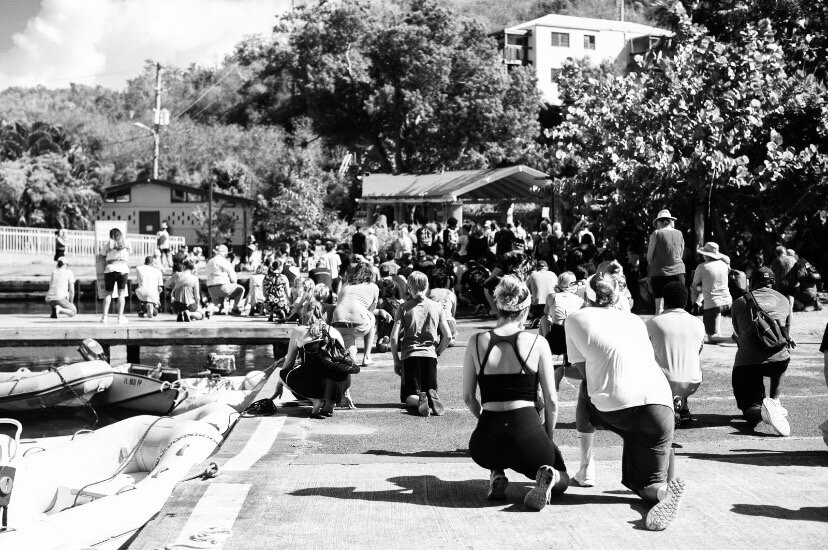Show, Don't Tell

I think I can speak for both Kevin and myself when I say that we have struggled this week to navigate our roles as 1. white Americans, who are physically distanced from what’s going on in our native country (though very much emotionally connected), 2. as individuals who have some influence on a social media platform (albeit a small one), 3. and perhaps the most confusing one of all, as former educators.
What should we say? What should we do? Where is it our place to speak up? Where is it our place to listen?
I’ve gone back and forth in my own mind, deciding whether to post and repost resources that many others have shared, or whether to take a step back, reflect, further educate myself, and listen to the voices that matter most: black voices. Ultimately, we’ve decided to do the latter.
Rather than flood Sunset Shanti’s feed with statements on where we stand (I hope y’all know by now where we stand on this issue), Kevin and I decided together that our best course of action was to remain active as viewers and listeners on social media, but to allow other voices to dominate the space over the course of the past week. Our reasoning circles back to the previous blog post we published last week: White People: It’s Not About Us - meaning, this movement and the conversations surrounding it should be centered around those who are directly impacted by racism and the violence incurred because of racist ideology, NOT around white guilt or performativity. (Ahem, Amazon … “Black Lives Matter: Amazon Stands in Solidarity with the Black Community” - a total PR stunt if you ask me.)
We must un-center ourselves.
That being said, we made the conscious, and difficult (perhaps controversial), decision to actively listen to the conversation, engage in our own self-education and reflection, and allow space for black protesters and activists to dominate the discussion, rather than impose our own (white) voices and perspectives on a narrative that, we feel, should be constructed and controlled by black authors.
Now that some time has passed, we’d like to add our perspectives to the narrative written by the black community. Our hope is that after the past week of engaging with and listening to black voices, our readers hold a deeper understanding of why #BlackLivesMatter is such a crucial movement in our nation’s history, and that each one of our white friends, followers, and family members understands their white privilege, and the changes that we all need to actively make, a little bit better.
To do so, we’ve decided to shed some light on our own experiences as educators - me in an under-resourced, over-crowded, and predominantly black public K-8 school in New Orleans East, and Kevin in a well-funded, predominantly white private episcopal K-8 school in New Orleans’ Lower Garden District. Our goal here is to showcase the glaring inequality that exists between these two settings, only miles apart - the themes of which can be universally applied to the American education system at large.
We see this as an avenue through which we can add our voices in a way that contributes to the conversation in an authentic way, by offering our own observations, based on our own experiences, in a way that compliments and supplements the black narrative, rather than attempting to project our voices above those whose voices matter more than our own.
The words that follow are a series of snippets, vignettes, if you will, of our lives teaching in these two very different educational environments in New Orleans. We alternate between perspectives, between my voice and Kevin’s, between New Orleans East and the Garden District, between a black setting and a white setting. We write these pieces in the ethnographic present, to encourage our readers to imagine themselves within the space. As you read, picture what the space looks like. Picture the students. Imagine the differences in setting, in resources, in the number of students in each classroom. Imagine the extremes, because that is precisely what they were.
As a former English teacher, I’ve tried to drill into my students’ heads that “showing” rather than “telling” is the best way to illustrate a point in their writing. The point here is that racism within our education system is rampant, that our system views white lives and white opportunities as inherently more valuable than black lives and the opportunities offered to students of color; what follows is our attempts at illustrating this point with our words.
**Please note that we’ve changed the names of the students and omitted the names of the schools to protect children’s privacy.
~
Isabel
New Orleans East, Louisiana
September, 2016
“Shut the fuck up, you stupid white bitch. You can’t tell me nothin’.”
Instinctively, I jump to my left and crouch to the floor. I throw my hands over my head to protect my neck as Michael hurls a desk at my body, its legs creaky and wobbling on rusty hinges. It knocks my side, and Michael storms out of the room. Some kids laugh, others stare blankly. A few shocked, frozen faces search my body with their eyes, afraid of what they might see. I stand up, shaken by what has just happened, but otherwise unharmed, save for the bruise that I feel slowly forming on my left hip.
My right hand is trembling. “Please continue reading Chapter 2 silently and independently,” I say. I hear the tremor in my own words, embarrassed that my students can sense my fear. I rack my brain, desperately trying to make sense of Michael’s outburst. I had asked him to sit down, the way I do with any of my students who move around when sitting down is the expectation - 36 students in one small classroom, me being the only teacher present, means that micromanagement is a must.
I send a message for help, and to let the administration know that Michael is wandering around the building. A few minutes later, a culture team member marches him right back in, stating that if he gives me any more trouble, she’s going to call his mama.
“I don’t care!” he yells as she walks away.
Later that day, the school counselor - the only counselor for over 800 students - tells me she has visited Michael’s home. His family - Michael, along with his mother, two sisters, brother, and cousin - are all living in the same one-bedroom apartment. There is no furniture, save a queen-sized, two-inch foam mattress topper and a blanket on the floor. Mom says that last night was Michael’s shift sleeping on the concrete. He didn’t sleep much, and was cranky when he left for school this morning. She asks that we please give him an appropriate consequence for his actions, and she will address him accordingly when he gets home as well, but could we please not suspend him. She is working three shifts today so that she can buy him a new pair of socks - he has worn through his old pair, and other students have been picking on him for his smelly feet. She cannot afford to take time off work to stay home with Michael.
~
Kevin
Lower Garden District, New Orleans, Louisiana
March, 2015
This is unreal. The advisory group I’ve been assigned to for the school tour is the last group to settle into the expansive space adjacent to the school. It’s eerily quiet given the number of students grades 1 - 8 that are present.
There’s clearly a routine, and, as a prospective new teacher, I’m taking cues from 12-year-olds who are lazily anticipating each and every step. Gleeful whispers are aggressively shushed as I briefly make eye contact with kids as they’re caught staring at the new guy.
On the altar, the younger of the two adults rises from his kneeled position and says some words, and now everyone is standing and taking out the blue books from behind the benches, or pews, or whatever.
And now we’re singing.
Everyone is singing, some referencing the book, hymnal, or whatever, and some are reciting from memory. Given that we’re in the back, I take this time to visually digest the sheer magnitude and grandiosity of the church. The ceiling is at least three stories high flanked by 20-foot stained glass windows each depicting a different story about Christ. There must be 60 rows of 8 columns worth of seating, not to mention the balcony seating in the back. Everything is clean. The altar is precisely arranged with intricate railings, tables, pews, and chairs all glimmering from the purposeful lighting from high above. I didn’t know wood could shine like that. The largest organ I have ever seen, and probably will ever see, has come to life and is beaming with song, giving cadence to all of those who are singing.
Now we’re, chanting? Nope, a prayer, the lord’s prayer? I don’t know the lord’s prayer.
All of the kids and teachers are participating and it’s striking to see this done in uniformity. The current school where I teach has gatherings for morning assemblies every day, but not to the extent of this disciplined congregation. This is wild.
It’s quiet again and the younger of the two at the altar, the chaplain, invites an 8th-grade student up to the front. She quietly rises and makes her way up to where what I assume is a giant gospel. It’s really quiet.
She finishes reading the passage and as quietly as she walked to the altar, she quietly walks back. The older of the two men, the Head of School, rises and begins to deliver what I later learn is a homily.
For the next three years, I aloofly participated in this routine but always in awe of the sheer magnitude of this space, finding new details to ponder as I mindlessly participated in each and every step.
~
Isabel
New Orleans East, Louisiana
April, 2017
Thump. Thump. Thump. Thump.
I listen to the rhythmic pounding of forehead against concrete wall. Her hands are clenched in tight fists. Razor-sharp nails, decorated in purple marker, dig themselves into the life line creases of her palms. Her eyes, a beautiful shade of mahogany, outlined with lashes that give her eyes an exaggerated roundness, stare fixated, unblinking, at the white-coated cinder blocks as she rocks back and forth. Her full cheeks are coated in wetness, her jaw clenched firmly. She lets out one long shrill cry, a release of pent up emotion.
I am afraid. I look around me for help, but the only being I see between us and the flickering light at the end of the windowless hallway is a juicy cockroach that scampers across the floor to a crack in the cement, where it burrows itself and disappears. I move closer to Michelle, slowly, every movement of my body deliberately calculated to minimize any sense of perceived threat.
“Don’t touch me,” she screams. I take a step back.
“I’m not going to hurt you, Michelle. I promise,” I say with hyperbolic gentleness. I sit down on the floor across the hallway from where she stands. “Come sit by me, please? We can talk, or not talk. Just, please, come sit down.”
I think she senses my desperation. The thumping stops, and, without lifting her feet, Michelle slides her body and sits down beside me. She hugs her knees and continues to rock back and forth. Rhythm seems to feel comforting.
Moments of silence pass. Finally, Michelle breaks our shared silence with a whisper so faint, I’m not sure if I’m imagining it. “I want my mom,” she says. Knowing that her mother is behind bars and will remain that way for years to come, I wrap my arms around her trembling body. She does not resist. As we sit together in the hallway, the trembling of her body slowly begins to ease. Her eyelids begin to fall. Her muscles go limp, and Michelle falls into a deep, peaceful sleep.
~
Kevin
Lower Garden District, New Orleans, Louisiana
April, 2016
What the fuck, is she tearing up?
We went to the school to grab a few things out of my classroom and I wanted to show Isabel the supply closet. Every once in a while I’d grab a box of pencils, markers, erasers, etc. and bring them home so Isabel could bring them to her classroom. No such room existed at her school and she was responsible for purchasing any classroom supplies that she needed. I thought this was a good gesture.
It’s not a huge closet, but not a small one either. Three or four adults could be in here comfortably, scanning shelves worth of tissue paper, paper towels, construction paper and drawers full of smooth-glide pens, No. 2 pencil boxes, and assorted colors of white-board markers. The Middle School Head made it a mission to keep this room well-stocked, and it was rare that I wouldn’t find what was needed.
We’re here all alone on a weekend in what was supposed to be a quick stop with no intended drama, and now she has tears in her eyes.
“What’s wrong? What did I do? Are you ok?”
I’m confused, and because I’m confused, I feel like I’ve done something wrong, and because I feel as though I’ve done something wrong, I’m starting to get mad. What the hell did I do? Why is she upset?
She knows she looks distressed and she doesn’t want to look that way so it’s quiet for a while…
I don’t understand, I bring her stuff when I can. Is she upset that I don’t do it more often? I can’t do that, here and there I can justify, but any more than that and it amplifies the fact that what I do is theft. I don’t want to do that!
This is stupid. We shouldn’t have come here, I can’t believe what’s happening. How could she possibly be upset? This is a no-nonsense trip, just a quick peek at the supply storage that I frequently speak of.
Is she overwhelmed? Is this joy? I’ve brought her straight to the source, could this be that she’s taking in all that’s in stock? Maybe this is a good thing! But I think we should hurry up, I don’t want to be here any longer than needed. I don’t want to get caught.
“Hey, so yea, what’s going on?” She shakes her head. “Ok, well let’s grab a few things and head out then.”
Finally, “This is really overwhelming. I had no idea places like this existed. My kids are expected to bring their own materials and they have nothing.”
…
“I buy the stupid golf pencils, because they’re cheaper and you guys have anything and everything I could ever imagine. This is fully stocked and unlocked! It’s just here. All of it. Three-ring binders, thick pads of paper, staples, and just everything. This would be raided in a hot sec.”
I know that our school experiences are different, but this is the closest I have come to living it.
~
Isabel
New Orleans East, Louisiana
October, 2017
Keith, who calls himself “Yung Prince,” bursts through my closed classroom door. It’s my planning period - my only break, a 30-minute period during the 8 AM - 5 PM school day (yes, 5 PM; we share the school buses with the kids in the Garden District, meaning those kids must be gathered from their schools and dropped off at their various locations before the bus makes its way out to New Orleans East to pick up our kids) - and I have to finish writing report card comments for all of my 120 fourth graders by the end of the day.
Keith slams the door behind him and beats his fist into the table. He’s shaking and mumbling something incomprehensible. I get up and briskly move toward him.
“Keith,” I say, “What is going on?” He starts to ramble about how “he did me this” or “he was sayin’ that.”
“Take a deep breath,” I tell him, placing a hand on his shoulder. “I’m listening.”
“Darren kicked me,” he says.
“Why would he do that?” I ask, knowing that Darren is known to cause trouble, but that Keith will also provoke his peers.
“He be sayin’ that my daddy don’t love me and that’s why he gone. But that ain’t right ‘cause my daddy be in jail. He don’t know.”
“How did that make you feel?” I ask.
“I be mad!” he says. A pause and then, “I hit him.”
“Is he okay?”
“Yeah, he be fine.” Keith bursts into tears. “I didn’t mean to hit him. I don’t wanna be like that. But I got so mad. I miss my daddy. I don’t wanna be like that.”
Keith buries his face into my neck. I feel tears and snot soaking through my shirt, but I let him cry.
“Look at me,” I say finally, taking his chin in between my thumb and forefinger and looking him directly in the eye. “You are a good person, Keith. You know how I know? Because I can tell how badly you feel about hitting Darren. You made a bad choice, but there is a big difference between making a bad choice and being a bad person. Use this as a learning experience. Next time, try to remember how you feel right now, and try to make a better choice.”
Keith wipes his cheeks. “Can I go find Darren and apologize?”
“Of course,” I say. “I’m proud of you.”
Keith grabs my copy of Trombone Shorty’s illustrated autobiography - his favorite book, which he always asks to read when he is feeling overwhelmed or anxious, and walks back outside. A few minutes later, I peer through my window and see Keith and Darren sitting in the shade of the live oak tree in the yard, laughing and reading about Trombone Shorty, their beloved New Orleanian musician and hero, together.
~
Kevin and I both had profoundly meaningful experiences during our years as educators. What we learned individually pales in comparison to what we learned from one another. Each of our experiences gave context and perspective to the other.
In the mornings, we’d wake up, get dressed, and head out to our perspective classrooms for the day - under the same umbrella label of “teacher.” We left from the same house, but once we hit the end of our street, Kevin turned right toward St Charles Avenue, drove alongside the famous New Orleans streetcar, glorious historic mansions dotting the street on either side; I turned left toward the I-10, climbed the ramp heading eastbound, and watched the New Orleans city skyline fade in my rearview mirror, toward the swampland on the other side of the High Rise Bridge: New Orleans East.
In the evenings, we would reconvene at our sweet little Uptown apartment. At the end of a long day and a long drive home during rush hour traffic, I would come home to find Kevin cooking, cleaning, and ready to rub my dirty, swollen feet. We’d share stories from our days, laughing at some of the absurd things children say and do, crying at the flagrant disparity between our two working environments and the greater implications that disparity had on our society at large. We’d comfort each other, teach each other, learn from one another, and grow, both individually and as a pair.
I’d like to point out that the moments we’ve each chosen to highlight here are simply glimpses of what we experienced of our students’ lives - to each of these individuals, there is more depth than we could ever capture in a short vignette. It is important to note, however, that the differences in experience that we seek to illustrate here are deeply rooted in the pervasive racist ideology that constructs America’s most elemental systems, of which education is only one.
So, why does this matter now, within the context of the Black Lives Matter movement, George Floyd’s death, the protests and riots taking place across the country?
It matters because racism exists even at the most fundamental levels within our society. Racism and racist ideology are deeply woven into the fabrics that make up this country - they always have been, and, unless we collectively take an active stand against it and make concrete continual changes, they always will be.
Enough is enough. Black lives FUCKING matter. The children I taught and loved in New Orleans East FUCKING matter. George Floyd FUCKING mattered. Breonna Taylor FUCKING mattered. ALL black people FUCKING matter.
It’s time for a change. Let’s FUCKING do better.
Please don’t let this post be the end of your education on racism in America. PLEASE listen to black voices, let black authors write the narrative, and encourage white voices to be a secondary contribution to this black chronicle of history.
Here is a list of some of my personal favorite books, both fiction and nonfiction, written by black authors, who use this “Show, Don’t Tell” method to illustrate racism in its most pervasive forms:
The Bluest Eye - Toni Morrison
I Know Why the Caged Bird Sings - Maya Angelou
Men We Reaped - Jesmyn Ward
Salvage the Bones - Jesmyn Ward
Sing, Unburied, Sing - Jesmyn Ward
The Sun Does Shine - Anthony Ray Hinton
A Small Place - Jamaica Kincaid
The Water Dancer - Ta-Nehisi Coates
This is just a short list of a few works that immediately come to mind; there are many more. If anyone has personal recommendations they would like to add for additional books written by black authors that help to illustrate racism in America, please add your recommendations in the comments section below!
Taking a knee during St. John’s Black Lives Matter peaceful protest: Cruz Bay, June 6, 2020
Marching for Black Lives Matter (spot Kevin in the middle): Cruz Bay, June 6, 2020
Credit: STJ Creative Photography
Black Lives Matter protest: Cruz Bay, June 6, 2020
Credit: STJ Creative Photography
Black Lives Matter Protest, Aerial View 1: Cruz Bay, June 6, 2020
Credit: STJ Creative Photography
Black Lives Matter Protest, Aerial View 2: Cruz Bay, June 6, 2020
Credit: STJ Creative Photography
Black Lives Matter Protest, Aerial View 3: Cruz Bay, June 6, 2020
Credit: STJ Creative Photography






